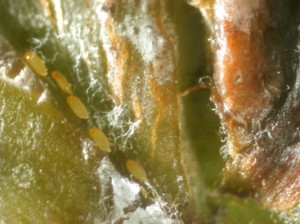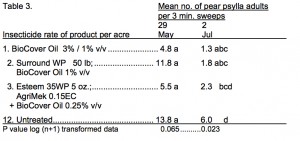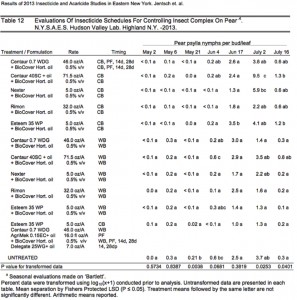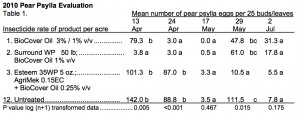Pears psylla: In most mid-Hudson Valley pear blocks we are now at early bud bust. The egg numbers have now peaked from 44 eggs over 100 buds on 14 April to 1441 eggs in 100 buds in today’s count (2014 Scouting Report). 
 Although we have not seen pear psylla nymph hatch, the increasing leaf development provides significant seclusion for egg laying, making it more difficult to target eggs. If you have a single oil application on the trees you have delayed egg laying and should be applying a second application of 1-2% oil. A follow-up application of oil at this stage will reduce egg viability and deposition onto newly developing foliage. If the egg has a dilute coating, the oil will dissolve the adherence of the egg to the shoot, causing it to drop.
Although we have not seen pear psylla nymph hatch, the increasing leaf development provides significant seclusion for egg laying, making it more difficult to target eggs. If you have a single oil application on the trees you have delayed egg laying and should be applying a second application of 1-2% oil. A follow-up application of oil at this stage will reduce egg viability and deposition onto newly developing foliage. If the egg has a dilute coating, the oil will dissolve the adherence of the egg to the shoot, causing it to drop.
As the majority of the adult population has moved into the orchard, adding a select adulticide to the tank would be a sound tactic (Chart 1). We have seen the pyrethroids lose their ability to control the adults over the past ten years. The pyrethroids, in IRAC Group 3, include Ambush 25WP & Pounce 25WP, both @ 12.8-25.6oz./A, Asana XL 0.66EC @ 9.6-19.12 fl.oz./A, Danitol 2.4EC 16-21.3 fl.oz./A and Warrior II 2.08CS @ 1.28-2.56 fl.oz./A. From work done in 2005 we found the use of Asana improved against the adult if the product Incite (Piperonyl butoxide) was added to the tank mix to reduce the detoxification mechanism of the pyrethroid (Graph 2). 
With the propensity of pear psylla to develop resistance to insecticides over time, developing a strategy of insecticide resistance management throughout the season, using of a single active ingredient for each of the four generations should be considered now to minimize selection pressure. The robust active ingredient list available for pear psylla management provides a number of labeled materials in no less then 7 modes of action (MOA) groups. Moving away from the pyrethroids makes sense, especially as weather warms and these tools become less effective.
When Psylla nymphs do hatch, they find their way into clusters, well hidden from contact applications and oil applications. However, the neonicintoids have translaminar movement into new tissue to control secluded nymph populations. Of the insecticides in group 4, (Assail, Actara, Provado and Calypso), Actara appears to have excellent efficacy against both adult and nymph populations (Graph 2). Employing oil and the neonicotinoids during the first generation would be one choice in resistance management strategy. Actara does have bee activity and should be halted once white bud develops.
A case for IGR’s: Another choice would include a newer mode of action such as the insect growth regulators. Two labeled products in these groups Centaur WDG (Buprofezin) at 34.5 to 46.0 oz/acre is a is a chitin biosynthesis inhibitors in group groups 16, and Esteem (Pyriproxyfen), at 13-16 oz./A is a juvenile hormone mimic in group 7C. Both of these products can be used with oil. Centaur can be used up to bloom and petal fall with no more then 2 applications per season, providing efficacy against psylla nymphs as they develop (Table 1). These IGR’s also provide efficacy against overwinter immature and crawler stages of scale and mealy bug if they have been a problem in pear the previous year.
The use of Surround and oil are also important tools to reduce egg laying and may reduce the selection pressure for the development of resistance of insecticides used later in the season. A video describing the use of these products can be found here: Pear Psylla – Oil and Surround to reduce egg laying
Apple: We are presently seeing Ginger Gold at early tight cluster with increasing red banded leaf roller and spotted green fruit worm adult trap captures. No signs of larval presence or feeding thus far on apple. Applications for San Jose scale control should be underway with insect growth regulators (Centaur & Esteem) being applied at the next available opportunity. The use of Lorsban delayed to the pink stage of apple would optimize obliquebanded leafroller, green fruit worm, red banded leafroller and early plum curculio management.


